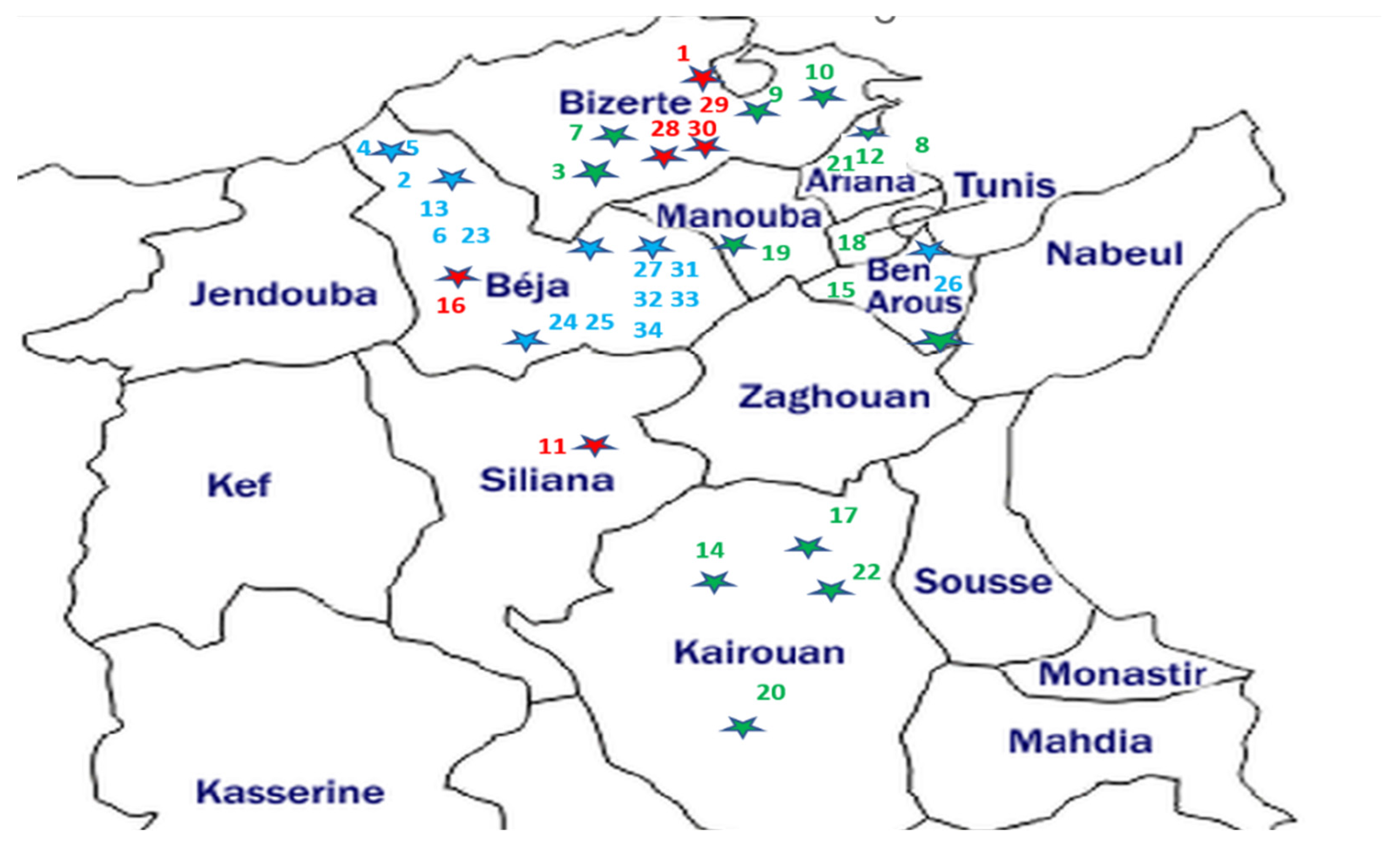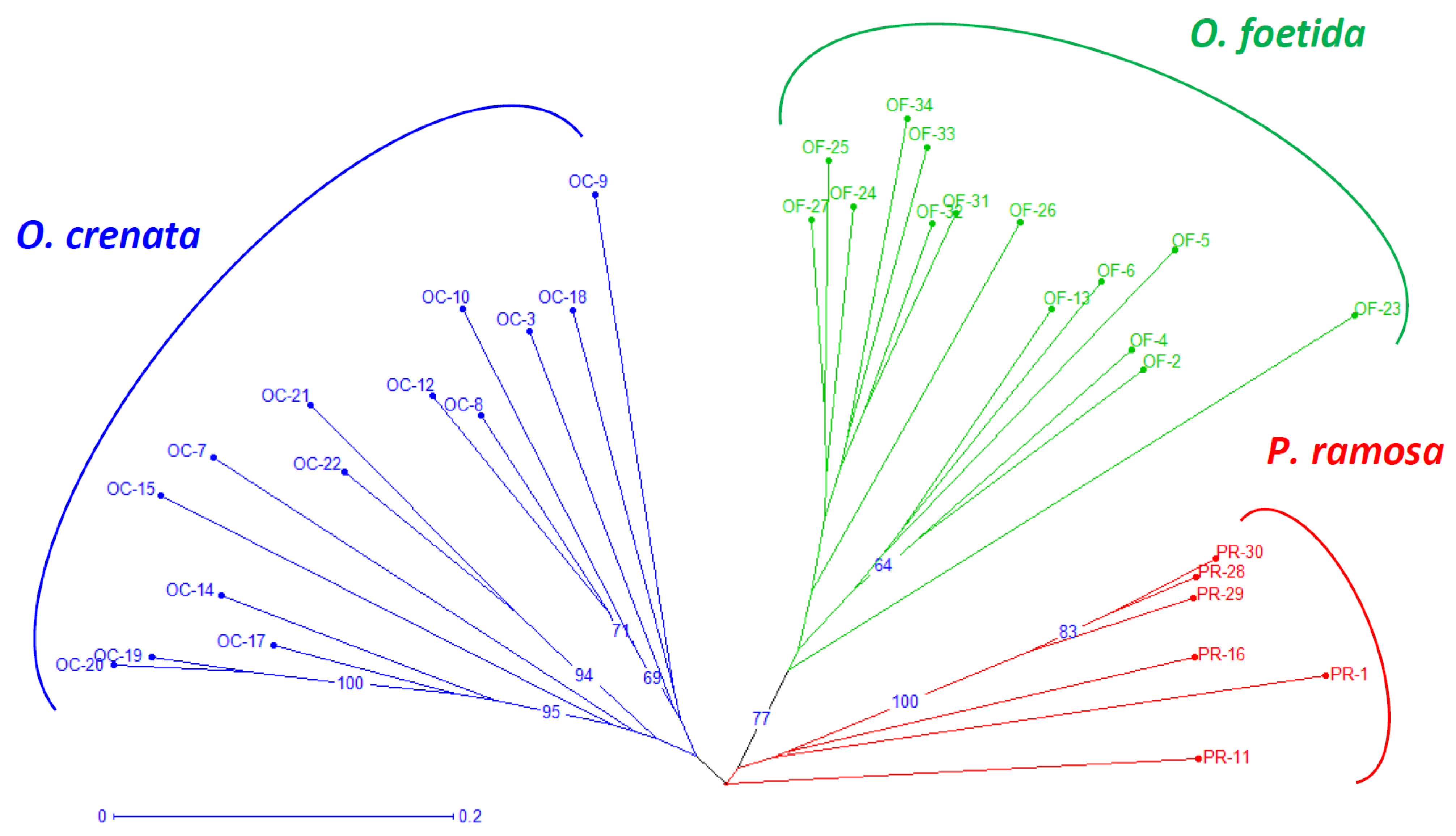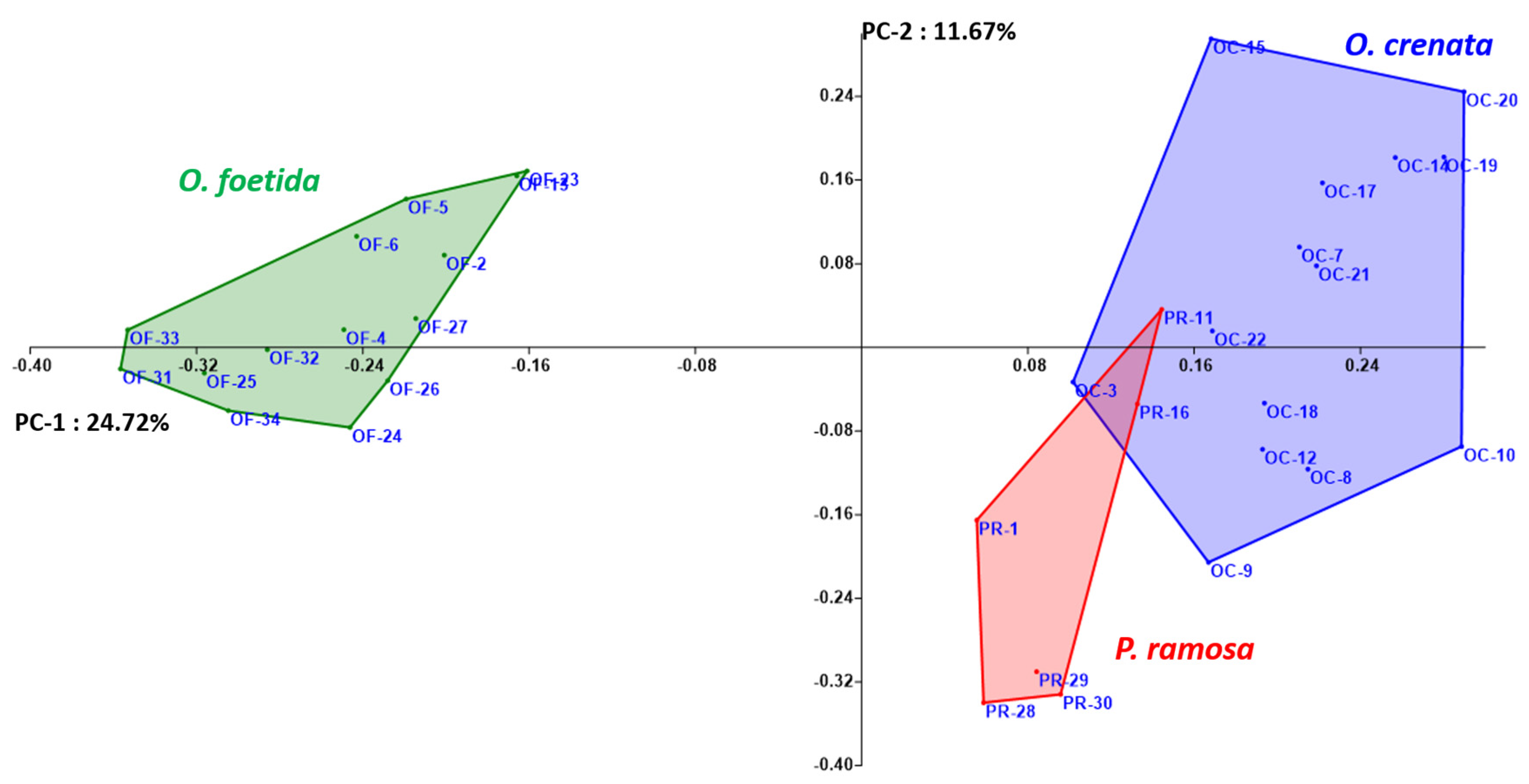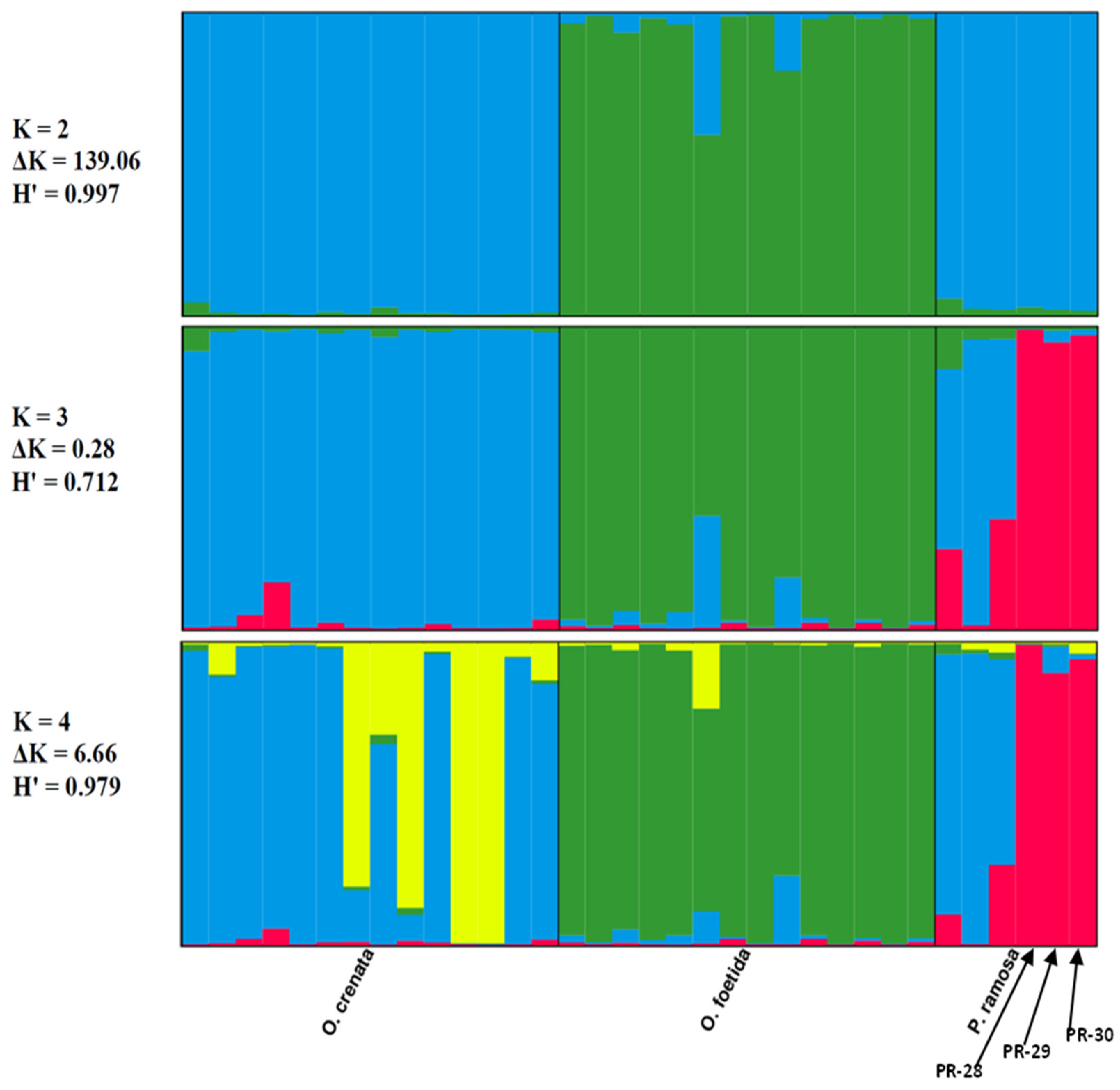Genetic Structure and Diversity Analysis of Tunisian Orobanche spp. and Phelipanche spp. Using Molecular Markers
Abstract
:1. Introduction
2. Materials and Methods
2.1. Sampled Broomrapes and Their Geographic Localization
2.2. DNA Extraction Protocol
2.3. Primer and Polymorphic Chain Reaction (PCR) Condition
2.4. Data Analysis
3. Results
3.1. RAPD Polymorphism
3.2. Genetic Diversity and Structure Explored Using RAPD Markers
- -
- Alleles from different loci never co-migrate in a gel;
- -
- Each locus has bi-allelic determinism.
3.3. Neighbor-Joining Method and Principal Coordinate Analysis
3.4. Tunisian Broomrape’s Genetic Structure
4. Discussion
5. Conclusions
Author Contributions
Funding
Institutional Review Board Statement
Informed Consent Statement
Data Availability Statement
Acknowledgments
Conflicts of Interest
References
- Joel, D.M. The new nomenclature of Orobanche and Phelipanche. Weed Res. 2009, 49, 6–7. [Google Scholar] [CrossRef]
- Satovic, Z.; Joel, D.M.; Rubiales, D.; Cubero, J.I.; Román, B. Population genetics in weedy species of Orobanche. Australas. Plant Pathol. 2009, 38, 228–234. [Google Scholar] [CrossRef]
- Rubiales, D. Broomrape Threat to Agriculture. Outlooks Pest Manag. 2020, 31, 141–145. [Google Scholar] [CrossRef]
- Amri, M.I.; Trabelsi, Z.A.; Kharrat, M. Release of a new faba bean variety “chourouk” resistant to the parasitic plants Oroban-che foetida and O. crenata in Tunisia. Intl. J. Agric. Biol. 2019, 21, 499–505. [Google Scholar]
- Amri, M.; Abbes, Z.; Youssef, S.; Bouhadida, M.; Salah, H.; Kharrat, M. Detection of the parasitic plant, Orobanche cumana on sunflower (Helianthus annuus L.) in Tunisia. Afr. J. Biotechnol. 2012, 11, 4163–4167. [Google Scholar]
- Hosni, T.; Abbes, Z.; Abaza, L.; Medimagh, S.; Ben Salah, H.; Kharrat, M. Effect of broomrape (Orobanche cumana Wallr.) on some agro-morphological and biochemical traits of Tunisian and some reference sunflower (Helianthus annuus L.) accessions. J. Plant Dis. Prot. 2020, 127, 831–841. [Google Scholar] [CrossRef]
- Medimagh, S.; Abbes, Z.; Chtourou, M.; Hosni, T.; Khamassi, K.; Kharrat, M. Detection of the parasitic weed, Phelipanche ra-mosa in rapeseed fields in Tunisia. In Proceedings of the International Scientific Workshop on Parasitic Plants Oroban-che/Phelipanche spp. Organised by PRIMAII “ZeroParasitic” Project Tunis (INRAT), Tunis, Tunisia, 14–16 March 2023. [Google Scholar]
- Parker, C. The Parasitic Weeds of the Orobanchaceae. In Parasitic Orobanchaceae: Parasitic Mechanisms and Control Strategies; Joel, D.M., Gressel, J., Musselman, L.J., Eds.; Springer: Berlin/Heidelberg, Germany, 2013; pp. 313–344. [Google Scholar] [CrossRef]
- Trabelsi, I.; Abbes, Z.; Amri, M.; Kharrat, M. Study of some resistance mechanisms to Orobanche spp. Infestation in faba bean (Vicia faba L.) breeding lines in Tunisia. Plant Prod. Sci. 2016, 19, 562–573. [Google Scholar] [CrossRef]
- Fernández-Aparicio, M.; Delavault, P.; Timko, M.P. Management of Infection by Parasitic Weeds: A Review. Plants 2020, 9, 1184. [Google Scholar] [CrossRef]
- Boukteb, A.; Sakaguchi, S.; Ichihashi, Y.; Kharrat, M.; Nagano, A.J.; Shirasu, K.; Bouhadida, M. Analysis of Genetic Diversity and Population Structure of Orobanche foetida Populations from Tunisia Using RADseq. Front. Plant Sci. 2021, 12, 618245. [Google Scholar] [CrossRef]
- Martín-Sanz, A.; Malek, J.; Fernández-Martínez, J.M.; Pérez-Vich, B.; Velasco, L. Increased Virulence in Sunflower Broomrape (Orobanche cumana Wallr.) Populations from Southern Spain Is Associated with Greater Genetic Diversity. Front. Plant Sci. 2016, 7, 589. [Google Scholar] [CrossRef]
- Ahmad, N.; Tian, R.; Lu, J.; Li, G.; Sun, J.; Lin, R.; Zhao, C.; Zhou, C.; Chang, H.; Zhao, S.; et al. DNA fingerprinting and genetic diversity analysis in Asparagus officinalis L. cultivars using microsatellite molecular markers. Genet. Resour. Crop Evol. 2023, 70, 1163–1177. [Google Scholar] [CrossRef]
- Ahmad, N.; Tian, R.; Li, G.; Zhao, C.; Fan, S.; Sun, J.; Zhao, S.; Wang, X. Establishment of male-specific sequence-tagged site markers in Asparagus officinalis: An efficient tool for sex identification. Plant Breed. 2022, 141, 471–481. [Google Scholar] [CrossRef]
- Katzir, N.; Portnoy, V.; Tzuri, G.; Joel, D.M.; Castejón-Muñoz, M.J.T.; Genetics, A. Use of random amplified polymorphic DNA (RAPD) markers in the study of the parasitic weed Orobanche. Theor. Appl. Genet. 1996, 93, 367–372. [Google Scholar] [CrossRef] [PubMed]
- Brault, M.; Betsou, F.; Jeune, B.; Tuquet, C.; Sallé, G. Variability of Orobanche ramosa populations in France as revealed by cross infestations and molecular markers. Environ. Exp. Bot. 2007, 61, 272–280. [Google Scholar] [CrossRef]
- Ivanović, Ž.; Marisavljević, D.; Marinković, R.; Mitrović, P.; Blagojević, J.; Nikolić, I.; Pavlović, D. Genetic Diversity of Oroban-che cumana Populations in Serbia. Plant Pathol. J. 2021, 37, 512–520. [Google Scholar] [CrossRef] [PubMed]
- Román, B.; Alfaro, C.; Torres, A.M.; Moreno, M.T.; Satovic, Z.; Pujadas, A.; Rubiales, D. Genetic relationships among Oroban-che species as revealed by RAPD analysis. Ann. Bot. 2003, 91, 637–642. [Google Scholar] [CrossRef]
- Stoyanov, K.; Gevezova, M.; Denev, I. Identification of ISSR Markers for Studying the Biodiversity of Bulgarian Representa-tives of Genus Orobanche Subsection Minores. Biotechnol. Biotechnol. Equip. 2012, 26, 2743–2749. [Google Scholar] [CrossRef]
- Westwood, J.H.; Fagg, C. ISSR characterization of Orobanche minor populations in the US. In Proceedings of the 8th Interna-tional Parasitic Weeds Symposium, Durban, South Africa, 24–25 June 2004; p. 15. [Google Scholar]
- Abdalla, M.M.F.; Saleh, H.A.M.A.; Khater, M.A. Detection of genetic variations in Orobanche crenata using inter simple se-quence repeat (ISSR) markers. Bull. Natl. Res. Cent. 2020, 44, 139. [Google Scholar] [CrossRef]
- Abedi, S.; Darvishzadeh, R.; Bernousi, I.; Abdollahi Mandoulakani, B.; Hatami Maleki, H.; Shah, D. Genetic variability of Oro-banche aegyptiaca infesting tobacco in Iran by Bayesian analysis. Biologia 2014, 69, 1652–1659. [Google Scholar] [CrossRef]
- Gagne, G.; Roeckel-Drevet, P.; Grezes-Besset, B.; Shindrova, P.; Ivanov, P.; Grand-Ravel, C.; Vear, F.; Tourvieille de Labrouhe, D.; Charmet, G.; Nicolas, P. Study of the variability and evolution of Orobanche cumana populations infesting sunflower in different European countries. Theor. Appl. Genet. 1998, 96, 1216–1222. [Google Scholar] [CrossRef]
- Vaz Patto, M.C.; Díaz-Ruiz, R.; Šatović, Z.; Román, B.; Pujadas-Salvà, A.J.; Rubiales, D. Genetic diversity of Moroccan popula-tions of Orobanche foetida: Evolving from parasitising wild hosts to crop plants. Weed Res. 2008, 28, 179–186. [Google Scholar] [CrossRef]
- Belay, G.; Tesfaye, K.; Hamwieh, A.; Ahmed, S.; Dejene, T.; de Oliveira Júnior, J.O.L. Genetic Diversity of Orobanche crenata Populations in Ethiopia Using Microsatellite Markers. Int. J. Genom. 2020, 2020, 3202037. [Google Scholar] [CrossRef]
- Pineda-Martos, R.; Velasco, L.; Fernández-Escobar, J.; Fernández-Martínez, J.M.; Pérez-Vich, B. Genetic diversity of Orobanche cumana populations from Spain assessed using SSR markers. Weed Res. 2013, 53, 279–289. [Google Scholar] [CrossRef]
- Rolland, M.; Dupuy, A.; Pelleray, A.; Delavault, P. Molecular Identification of Broomrape Species from a Single Seed by High Resolution Melting Analysis. Front. Plant Sci. 2016, 7, 1838. [Google Scholar] [CrossRef] [PubMed]
- Bendaoud, F.; Kim, G.; Larose, H.; Westwood, J.H.; Zermane, N.; Haak, D.C. Genotyping-by-sequencing analysis of Orobanche crenata populations in Algeria reveals genetic differentiation. Ecol. Evol. 2022, 12, e8750. [Google Scholar] [CrossRef] [PubMed]
- Benharrat, H.; Veronesi, C.; Theodet, C.; Thalouarn, P. Orobanche species and population discrimination using intersimple sequence repeat (ISSR). Weed Res. 2002, 42, 470–475. [Google Scholar] [CrossRef]
- Fulton, T.M.; Chunwongse, J.; Tanksley, S.D. Microprep protocol for extraction of DNA from tomato and other herbaceous plants. Plant Mol. Biol. Report. 1995, 13, 207–209. [Google Scholar] [CrossRef]
- Bouhadida, M.; Jannet, R.; Abbes, Z.; Amri, M.; Kharrat, M. Analysis of Genetic Diversity of Orobanche foetida Population Para-sitizing Crops Legume. J. Agric. Vet. Sci. 2015, 8, 37–40. [Google Scholar] [CrossRef]
- Gilbert, J.E.; Lewis, R.V.; Wilkinson, M.J.; Caligari, P.D.S. Developing an appropriate strategy to assess genetic variabil-ity in plant germplasm collections. Theor. Appl. Genet. 1999, 98, 1125–1131. [Google Scholar] [CrossRef]
- Román, B.; Hernández, R.; Pujadas-Salvá, A.J.; Cubero, J.I.; Rubiales, D.; Satovic, Z. Genetic diversity in two variants of Oro-banche gracilis Sm. [var. gracilis and var. deludens (Beck) A. Pujadas] (Orobanchaceae) from different regions of Spain. Electron. J. Biotechnol. 2007, 10, 221–229. [Google Scholar] [CrossRef]
- Román, B.; Rubiales, D.; Torres, A.M.; Cubero, J.I.; Satovic, Z. Genetic diversity in Orobanche crenata populations from south-ern Spain. Theor. Appl. Genet. 2001, 103, 1108–1114. [Google Scholar] [CrossRef]
- Smith, J.S.C.; Chin, E.C.L.; Shu, H.; Smith, O.S.; Wall, S.J.; Senior, M.L.; Mitchell, S.E.; Kresovich, S.; Ziegle, J. An evaluation of the utility of SSR loci as molecular markers in maize (Zea mays L.): Comparisons with data from RFLPS and pedigree. Theor. Appl. Genet. 1997, 95, 163–173. [Google Scholar] [CrossRef]
- Powell, W.; Morgante, M.; Andre, C.; Hanafey, M.; Vogel, J.; Tingey, S.; Rafalski, A. The comparison of RFLP, RAPD, AFLP and SSR (microsatellite) markers for germplasm analysis. Mol. Breed. 1996, 2, 225–238. [Google Scholar] [CrossRef]
- Yeh, F.; Yang, R.; Boyle, T. User Manual for POPGENE; Version 1.31; Microsoft Window-Based Freeware for Population Genetic Analysis. A Joint Project Development by Francis C. Yeh and Rong-Cai Yang, University of Alberta and Tim Boyle, Centre for International Forestry Research; Science Publishers: Montpellier, France, 1999. [Google Scholar]
- Nei, M. Analysis of gene diversity in subdivided populations. Proc. Natl. Acad. Sci. USA 1973, 70, 3321–3323. [Google Scholar] [CrossRef] [PubMed]
- Nei, M. F-statistics and analysis of gene diversity in subdivided populations. Ann. Hum. Genet. 1977, 41, 225–233. [Google Scholar] [CrossRef]
- McDermott, J.M.; McDonald, B.A. Gene Flow in Plant Pathosystems. Annu. Rev. Phytopathol. 1993, 31, 353–373. [Google Scholar] [CrossRef]
- Peakall, R.; Smouse, P.E. GenAlEx 6.5: Genetic analysis in Excel. Population genetic software for teaching and research—An update. Bioinformatics 2012, 28, 2537–2539. [Google Scholar] [CrossRef]
- Perrier, X.; Jacquemoud-Collet, J.P. DARwin Software, Desktop Standalone Version. Available online: http://darwin.cirad.fr/ (accessed on 1 July 2023).
- Hammer, O.; Harper, D.; Ryan, P. PAST: Paleontological Statistics Software Package for Education and Data Analysis. Palaeon-tol. Electron. 2001, 4, 1–9. [Google Scholar]
- Earl, D.A.; Vonholdt, B. Structure Harvester: A website and program for visualizing STRUCTURE output and implementing the Evanno method. Conserv. Genet. Resour. 2012, 4, 359–361. [Google Scholar] [CrossRef]
- Evanno, G.; Regnaut, S.; Goudet, J. Detecting the number of clusters of individuals using the software STRUCTURE: A simula-tion study. Mol. Ecol. 2005, 14, 2611–2620. [Google Scholar] [CrossRef]
- Jakobsson, M.; Rosenberg, N.A. CLUMPP: A cluster matching and permutation program for dealing with label switching and multimodality in analysis of population structure. Bioinformatics 2007, 23, 1801–1806. [Google Scholar] [CrossRef] [PubMed]
- Rosenberg, N.A. distruct: A program for the graphical display of population structure. Mol. Ecol. Notes 2004, 4, 137–138. [Google Scholar] [CrossRef]
- Ennami, M.; Briache, F.Z.; Gaboun, F.; Abdelwahd, R.; Ghaouti, L.; Belqadi, L.; Westwood, J.; Mentag, R. Host differentiation and variability of Orobanche crenata populations from legume species in Morocco as revealed by cross-infestation and mo-lecular analysis. Pest Manag. Sci. 2017, 73, 1753–1763. [Google Scholar] [CrossRef] [PubMed]
- Román, B.; Alfaro, C.; Maria, T.A.; Šatović, Z.; Kharrat, M.; Pujadas, A. An analysis of genetic variation in natural populations of Orobanche foetida from Spain and Tunisia. In Proceedings of the 7th International Parasitic Weed Symposium, Nantes, France, 5–8 June 2001; pp. 57–60. [Google Scholar]
- Boeuf, F.J.J.A.P. Les Orobanches en tunisie. J. Agric. Prat. 1905, 5, 11–14. [Google Scholar]
- Rubiales, D.; Sadiki, M.; Román, B. First Report of Orobanche foetida on Common Vetch (Vicia sativa) in Morocco. Plant Dis. 2005, 89, 528. [Google Scholar] [CrossRef] [PubMed]
- Rubiales, D.; Fernández-Aparicio, M.; Rodríguez, M.J. First Report of Crenate Broomrape (Orobanche crenata) on Lentil (Lens culinaris) and Common Vetch (Vicia sativa) in Salamanca Province, Spain. Plant Dis. 2008, 92, 1368. [Google Scholar] [CrossRef]




| id | Code | Population | Parasite Specie | Host Plant | Geographical Origin | GPS |
|---|---|---|---|---|---|---|
| 3 | OC-3 | pop1 | O. crenata | Geranium | Amdoun Beja | 36°43′28.1″ N 9°07′23.6″ E |
| 7 | OC-7 | pop1 | O. crenata | Milk thistle (Silybum marianum) | Fritissa Farm Bizerte | 36°55′21.6″ N 9°36′46.3″ E |
| 8 | OC-8 | pop1 | O. crenata | Lathyrus sativus | Ariana | 36°55′43.3″ N 10°02′38.9″ E |
| 9 | OC-9 | pop1 | O. crenata | Faba bean Vicia faba | Rasjbal_Bizerte | 37°13′30.6″ N 10°09′03.0″ E |
| 10 | OC-10 | pop1 | O. crenata | Faba bean Vicia faba | Rasjbal_Bizerte | 37°12′56.3″ N 10°08′45.9″ E |
| 12 | OC-12 | pop1 | O. crenata | The sweet pea Lathyrus odoratus | Rn7 Tunis | 36°50′06.6″ N 10°03′25.7″ E |
| 14 | OC-14 | pop1 | O. crenata | Faba bean Vicia faba | Abida Kairouan | 35°35′31.5″ N 10°00′26.1″ E |
| 15 | OC-15 | pop1 | O. crenata | Milk thistle (Silybum marianum) | Megrine Ben Arous | 36°46′15.2″ N 10°14′24.7″ E |
| 17 | OC-17 | pop1 | O. crenata | Milk thistle (Silybum marianum) | Farm 1 Kairouan | 35°36′13.6″ N 9°53′43.5″ E |
| 18 | OC-18 | pop1 | O. crenata | Lathyrus sativus | Ariana | 36°56′04.9″ N 10°02′49.6″ E |
| 19 | OC-19 | pop1 | O. crenata | Milk thistle (Silybum marianum) | Elbaten Kairouan | 35°71′55.80 N 10°00′45.33″ E |
| 20 | OC-20 | pop1 | O. crenata | Faba bean Vicia faba | Sidi Ali Kairouan | 35°35′00.2″ N 9°54′01.5″ E |
| 21 | OC-21 | pop1 | O. crenata | couch grass Elymus repens | El Menzah 4 Tunis | 36°50′16.6″ N 10°11′01.3″ E |
| 22 | OC-22 | pop1 | O. crenata | Milk thistle (Silybum marianum) | Abida Kairouan | 35°35′30.8″ N 9°58′47.4″ E |
| 2 | OF-2 | pop2 | O. foetida | Faba bean Vicia faba | Amdoun Beja | 36°43′28.1″ N 9°07′23.6″ E |
| 4 | OF-4 | pop2 | O. foetida | Chickpea Cicer arietinum | Amdoun Beja | 36°43′28.1″ N 9°07′23.6″ E |
| 5 | OF-5 | pop2 | O. foetida | Lathyrus sativus | Amdoun Beja | 36°43′28.1″ N 9°07′23.6″ E |
| 6 | OF-6 | pop2 | O. foetida | Faba bean Vicia faba | Oued Beja Beja | 36°44′07.2″ N 9°13′33.4″ E |
| 13 | OF-13 | pop2 | O. foetida | Chickpea Cicer arietinum | Amdoun Beja | 36°47′59.8″ N 9°06′29.6″ E |
| 23 | OF-23 | pop2 | O. foetida | Faba bean Vicia faba | Oued Beja Beja | 36°44′07.2″ N 9°13′33.4″ E |
| 24 | OF-24 | pop2 | O. foetida | Chickpea Cicer arietinum | El Hamrounia Beja | 36°43′24.2″ N 9°07′13.4″ E |
| 25 | OF-25 | pop2 | O. foetida | Faba bean Vicia faba | Farm Hamrounia Beja | 36°43′04.2″ N 9°07′15.8″ E |
| 26 | OF-26 | pop2 | O. foetida | Calicotome spinosa | Borj Cedria Benaours | 36°42′25.3″ N 10°23′55.5″ E |
| 27 | OF-27 | pop2 | O. foetida | Lentil lens culinaris | Lafareg Beja | 36°39′42.9″ N 9°05′25.4″ E |
| 31 | OF-31 | pop2 | O. foetida albinos | Faba bean Vicia faba | Oued Beja, Beja | 36°44′07.2″ N 9°13′33.4″ E |
| 32 | OF-32 | pop2 | O. foetida | Chickpea Cicer arietinum | Hammam Siala Beja | 36°39′39.6″ N 9°09′01.7″ E |
| 33 | OF-33 | pop2 | O. foetida | Medicago truncatula | Lafereg Beja | 36°39′42.9″ N 9°05′25.4″ E |
| 34 | OF-34 | pop2 | O. foetida | Medicago scutelata | Lafereg Beja | 36°39′42.9″ N 9°05′25.4″ E |
| 1 | PR-1 | pop3 | P. ramosa | Couch grass Elymus repens | Fritissa Bizerte | 36°55′21.6″ N 9°36′46.3″ E |
| 11 | PR-11 | Pop3 | P. ramosa | Tomato | Bargou-Siliana | 36°05′27.4″ N 9°34′22.1″ E |
| 16 | PR-16 | pop3 | P. ramosa | Oilseed rape Brassica napus: | Menchar Beja | 36°44′08.0″ N 9°14′19.7″ E |
| 28 | PR-28 | pop3 | P. ramosa | Couch grass Elymus repens | Ras Jebel_Bizerte | 37°13′34.5″ N 10°09′02.0″ E |
| 29 | PR-29 | pop3 | P. ramosa | Oilseed rape Brassica napus: | Bizerte | 37°08′49.0″ N 9°59′36.1″ E |
| 30 | PR-30 | pop3 | P. ramosa | Oilseed rape Brassica napus: | Bizerte Sidimechreg | 37°01′19.0″ N 9°39′40.3″ E |
| DNA Micro-Prep Solution | For 100 Samples |
|---|---|
| 2.5× DNA Extraction buffer CTAB 2X | 25 (mL) |
| 2.5× lysis buffer | 25 (mL) |
| 1 × 5% Sarkosyl (Sigma Aldrich, Baden-Württemberg, Germany) | 10 (mL) |
| Sodium Bisulfite (Sigma Aldrich, Baden-Württemberg, Germany) | 0.2 g |
| RNase Dnase-free (Vivantis) | 60 mL |
| Total volume to complete up to with Nuclease-free H2O (pH = 8) | 100 (mL) |
| Name of Primer | Primer Sequence (5′-3′) | References |
|---|---|---|
| OPF-03 | CCTGATCACC | |
| OPJ-10 | AAGCCCGAGG | |
| OPJ-01 | CCCGGCATAA | [31,34] |
| OPE-17 | CTACTGCCGT | [31,33,34] |
| OPD-20 | ACCCGGTCAC | |
| OPD-10 | GGTCTACACC | |
| OPH-13 | GACGCCACAC | |
| OPG-12 | CAGCTCACGA | |
| OPG-14 | GGATGAGACC |
| Component | Initial Concentration | Final Concentration | Volume/Sample (µL) | |
|---|---|---|---|---|
| 2X PCR master mix (Promega, USA) | MgCl2 | 3 mM | ||
| dNTPs | 400 µM each dNTP | 1× | 12.5 µL | |
| Primer Operon | 2 µM | 0.1 µM | 0.5 | |
| GoTaq DNA polymerase (Promega, USA) | 5 unit/µL | 1 unit/µL | 0.2 | |
| DNA | - | 30 ng/uL | 2 | |
| H2O nuclease-free | 11.8 | |||
| Number of Cycles | Temp (°C) | Time | |
|---|---|---|---|
| 1 | Initial denaturation | 94 | 4 min |
| 35 | Denaturation | 95 | 25 s |
| Hybridization | Annealing t°(c) | 25 s | |
| Extension | 72 | 1 min | |
| 1 | Post-extension | 35 | 5 min |
| Primer Code | TNB | NPB | PPB (%) | Rp | PIC | EMR | MI |
|---|---|---|---|---|---|---|---|
| OPB03 | 13 | 13 | 100 | 4.32 | 0.91 | 13.00 | 11.80 |
| OPD10 | 11 | 11 | 100 | 4.88 | 0.88 | 11.00 | 9.71 |
| OPD20 | 8 | 7 | 88 | 4.26 | 0.86 | 7.00 | 6.00 |
| OPE17 | 8 | 8 | 100 | 3.85 | 0.84 | 8.00 | 6.76 |
| OPF03 | 9 | 9 | 100 | 4.44 | 0.87 | 9.00 | 7.87 |
| OPG12 | 6 | 6 | 100 | 2.26 | 0.79 | 6.00 | 4.74 |
| OPG14 | 6 | 6 | 100 | 2.56 | 0.81 | 6.00 | 4.84 |
| OPH13 | 11 | 11 | 100 | 5.26 | 0.90 | 11.00 | 9.86 |
| OPJ01 | 15 | 15 | 100 | 6.82 | 0.92 | 15.00 | 13.79 |
| OPJ10 | 11 | 11 | 100 | 5.74 | 0.88 | 11.00 | 9.69 |
| Total | 98 | 97 | 44.41 | 97.00 | 85.06 | ||
| Mean | 9.80 | 9.70 | 98.98 | 4.44 | 0.87 | 9.70 | 8.51 |
| Population | Polymorphic Bands | Na | Ne | H | I | |
|---|---|---|---|---|---|---|
| No. | PPB (%) | |||||
| O. crenata | 90 | 91.84 | 1.918 | 1.566 | 0.325 | 0.483 |
| O. foetida | 79 | 80.61 | 1.806 | 1.441 | 0.261 | 0.395 |
| P. ramosa | 71 | 72.45 | 1.724 | 1.454 | 0.263 | 0.391 |
| Mean | 80 | 81.63 | 1.816 | 1.487 | 0.283 | 0.423 |
| Total | 97 | 98.98 | 1.989 | 1.612 | 0.358 | 0.533 |
| Source of Variation | d.f. | Sum of Squares | Mean Squares | % Variation | p-Value |
|---|---|---|---|---|---|
| Between Species | 2 | 175.269 | 87.634 | 29.69% | <0.001 |
| Within Species | 31 | 492.143 | 15.876 | 70.31% | <0.001 |
| Total | 33 | 667.412 | Φst = 0.297 |
Disclaimer/Publisher’s Note: The statements, opinions and data contained in all publications are solely those of the individual author(s) and contributor(s) and not of MDPI and/or the editor(s). MDPI and/or the editor(s) disclaim responsibility for any injury to people or property resulting from any ideas, methods, instructions or products referred to in the content. |
© 2023 by the authors. Licensee MDPI, Basel, Switzerland. This article is an open access article distributed under the terms and conditions of the Creative Commons Attribution (CC BY) license (https://creativecommons.org/licenses/by/4.0/).
Share and Cite
Khamassi, K.; Abbes, Z.; Tani, E.; Katsileros, A.; Guenni, K.; Rouissi, M.; Khoufi, S.; Chaabane, R.; Chachalis, D.; Kharrat, M. Genetic Structure and Diversity Analysis of Tunisian Orobanche spp. and Phelipanche spp. Using Molecular Markers. Appl. Sci. 2023, 13, 11622. https://doi.org/10.3390/app132111622
Khamassi K, Abbes Z, Tani E, Katsileros A, Guenni K, Rouissi M, Khoufi S, Chaabane R, Chachalis D, Kharrat M. Genetic Structure and Diversity Analysis of Tunisian Orobanche spp. and Phelipanche spp. Using Molecular Markers. Applied Sciences. 2023; 13(21):11622. https://doi.org/10.3390/app132111622
Chicago/Turabian StyleKhamassi, Khalil, Zouhaier Abbes, Eleni Tani, Anastasios Katsileros, Karim Guenni, Mustapha Rouissi, Sahari Khoufi, Ramzi Chaabane, Demosthenis Chachalis, and Mohamed Kharrat. 2023. "Genetic Structure and Diversity Analysis of Tunisian Orobanche spp. and Phelipanche spp. Using Molecular Markers" Applied Sciences 13, no. 21: 11622. https://doi.org/10.3390/app132111622
APA StyleKhamassi, K., Abbes, Z., Tani, E., Katsileros, A., Guenni, K., Rouissi, M., Khoufi, S., Chaabane, R., Chachalis, D., & Kharrat, M. (2023). Genetic Structure and Diversity Analysis of Tunisian Orobanche spp. and Phelipanche spp. Using Molecular Markers. Applied Sciences, 13(21), 11622. https://doi.org/10.3390/app132111622









